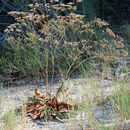fr
noms dans le fil d’Ariane


Limonium limbatum, common names trans-pecos sea-lavender or desert sea-lavender, is a plant species native to the southwestern United States (Arizona, New Mexico, Texas and Oklahoma) and the Mexican State of Coahuila. Most of the 300 species of the genus are found on seashores and in marine salt marshes, but L. limbatum also grows on the shores of salt lakes and in alkaline depressions in desert areas, at elevations of 400–1800 m.[1][2][3]
Limonium limbatum is a perennial herb with a large taproot, producing a rosette of leaves that are still alive at flowering time. Leaves are up to 17 cm long, thick and leathery. Flowering stalk is up to 100 cm tall, not winged, bearing flowers with whitish sepals and blue petals.[1][4][5][6]
Limonium limbatum, common names trans-pecos sea-lavender or desert sea-lavender, is a plant species native to the southwestern United States (Arizona, New Mexico, Texas and Oklahoma) and the Mexican State of Coahuila. Most of the 300 species of the genus are found on seashores and in marine salt marshes, but L. limbatum also grows on the shores of salt lakes and in alkaline depressions in desert areas, at elevations of 400–1800 m.
Limonium limbatum is a perennial herb with a large taproot, producing a rosette of leaves that are still alive at flowering time. Leaves are up to 17 cm long, thick and leathery. Flowering stalk is up to 100 cm tall, not winged, bearing flowers with whitish sepals and blue petals.
Devekulağı (Limonium limbatum), çok yıllık, otsu bir bitki türü. Çiçekli dalları koyun ve keçiler tarafından yenir. Haziran - Eylül ayları arası çiçek açar. Gövde uzunluğu 20 - 50 santimetre kadardır. Deniz seviyesinden 900 - 1200 metre yükseklikte tuzlu yerlerde yaşar. Genellikle Orta Anadolu'da yayılış gösterir.
Türkiye'ye özgü bir bitkidir.
Devekulağı (Limonium limbatum), çok yıllık, otsu bir bitki türü. Çiçekli dalları koyun ve keçiler tarafından yenir. Haziran - Eylül ayları arası çiçek açar. Gövde uzunluğu 20 - 50 santimetre kadardır. Deniz seviyesinden 900 - 1200 metre yükseklikte tuzlu yerlerde yaşar. Genellikle Orta Anadolu'da yayılış gösterir.
Türkiye'ye özgü bir bitkidir.